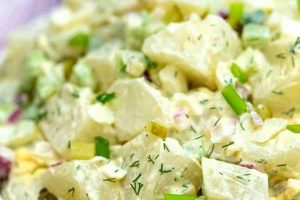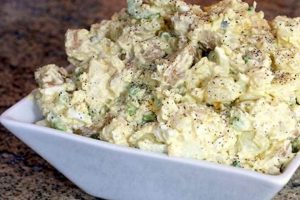A basic combination of cooked potatoes, hard-boiled eggs, and mayonnaise, often augmented with simple ingredients like celery, onion, mustard, and seasonings, forms the foundation of this classic dish. Variations can include different types of potatoes, additions like pickles or relish, and a range of seasonings from paprika to fresh herbs. A typical preparation involves boiling potatoes until tender, combining them with chopped hard-boiled eggs, and binding the mixture with mayonnaise and chosen seasonings.
This dish offers an economical and nutritious meal option, utilizing readily available ingredients. Its versatility makes it suitable for picnics, potlucks, quick lunches, or a light dinner. Historically, potato salad, in its various forms, has been a staple in many cultures for generations, reflecting the wide availability and adaptability of its core ingredients. The addition of eggs adds protein and richness, further enhancing its nutritional value.
The following sections will delve into specific ingredient selections, preparation techniques, variations, and serving suggestions to guide the creation of a satisfying and flavorful dish.
Tips for a Perfect Potato and Egg Salad
Achieving a well-balanced and flavorful salad requires attention to several key aspects, from ingredient selection to preparation techniques.
Tip 1: Potato Selection: Opting for waxy potatoes, such as red or new potatoes, ensures they hold their shape after boiling and contribute a creamy texture. Avoid starchy potatoes, which can become crumbly.
Tip 2: Optimal Boiling: Potatoes should be cooked until tender but not mushy. Slightly undercooking can result in a firmer texture, desirable in a salad. Cooling the potatoes completely before combining with other ingredients prevents mayonnaise from melting.
Tip 3: Egg Perfection: Perfectly cooked hard-boiled eggs are crucial. Overcooking can lead to a dry, chalky yolk. Immediately plunging the cooked eggs into ice water stops the cooking process and facilitates peeling.
Tip 4: Flavorful Enhancements: Finely diced celery and red onion add a refreshing crunch and subtle sharpness. Experiment with other additions such as chopped pickles, relish, or fresh herbs like dill or chives.
Tip 5: Seasoning Strategies: Mustard, both dry and prepared, adds depth of flavor. Salt, pepper, and paprika are classic seasonings, while a touch of cayenne pepper can provide a subtle kick.
Tip 6: Mayonnaise Matters: The quality and quantity of mayonnaise significantly impact the final result. Start with a good quality mayonnaise and add gradually, adjusting to achieve the desired consistency. A lighter version or a combination with plain yogurt can reduce overall fat content.
Tip 7: Chilling Time: Allowing the salad to chill for at least an hour in the refrigerator allows the flavors to meld and enhances the overall experience.
By following these guidelines, one can elevate a simple combination of ingredients into a truly satisfying and memorable dish.
The following section will explore variations on this classic recipe, offering options for customization and creative exploration.
1. Ingredient Quality
Ingredient quality significantly impacts the final outcome of a simple potato and egg salad recipe. While the recipe itself emphasizes simplicity, utilizing high-quality ingredients elevates the dish from basic to exceptional. This section explores the crucial role ingredient quality plays in achieving a superior potato and egg salad.
- Potato Selection
The type of potato influences the salad’s texture and flavor. Waxy potatoes, such as red or Yukon Gold, hold their shape well after boiling, creating a desirable texture. Conversely, starchy potatoes, like russets, tend to become mealy and fall apart, resulting in a less appealing salad. Selecting firm, unblemished potatoes ensures optimal flavor and texture.
- Fresh Eggs
Fresh, high-quality eggs contribute significantly to both flavor and texture. Fresh eggs bind better with the mayonnaise and other ingredients, creating a cohesive salad. Additionally, the yolks of fresh eggs possess a richer flavor and a more vibrant color, enhancing the overall aesthetic appeal of the dish.
- Mayonnaise Choice
Mayonnaise acts as the binder and contributes significantly to the overall flavor profile. Using high-quality mayonnaise, preferably one made with natural ingredients, elevates the taste and texture. Different mayonnaise varieties, such as those with added flavors like olive oil or Dijon mustard, can further enhance the complexity of the salad.
- Fresh Aromatics
Aromatic ingredients like celery, onions, and herbs contribute significantly to the freshness and flavor complexity of the salad. Using fresh, crisp aromatics, rather than wilted or older produce, enhances the brightness and overall sensory experience. Proper storage and timely usage of these ingredients ensure optimal flavor contribution.
By prioritizing quality ingredients, even a simple potato and egg salad can achieve a depth of flavor and textural complexity often absent in versions made with less attention to ingredient selection. The nuanced flavors derived from fresh, high-quality components elevate the dish, showcasing how ingredient quality plays a pivotal role in transforming a simple recipe into a culinary delight.
2. Proper Cooking
Proper cooking techniques are essential for a successful simple potato and egg salad recipe. The texture and flavor of both the potatoes and eggs significantly impact the final dish. Overcooked potatoes become mushy and lose their structural integrity, resulting in an unappetizing, gluey salad. Conversely, undercooked potatoes offer an unpleasant, firm texture. Similarly, overcooked eggs develop dry, chalky yolks and rubbery whites, detracting from the salad’s overall appeal. Conversely, undercooked eggs pose food safety risks. Achieving the correct cooking times for both ingredients ensures a pleasant texture and maximizes flavor.
Boiling potatoes until fork-tender, but not mushy, ensures they retain their shape when mixed with other ingredients. Maintaining an even boil prevents uneven cooking. Cooling the potatoes completely before adding mayonnaise prevents the dressing from breaking down. For the eggs, a properly timed hard boil yields firm whites and creamy yolks. Immediately plunging the cooked eggs into an ice bath stops the cooking process and facilitates peeling. These precise cooking methods, while seemingly minor, significantly influence the final salad’s quality and enjoyment. For example, a properly cooked potato will absorb the dressing’s flavors more effectively than an overcooked one, demonstrating the interconnectedness of cooking technique and flavor development.
Mastering these fundamental cooking techniques elevates the simple potato and egg salad from ordinary to exceptional. The resulting salad features distinct textures and flavors, demonstrating the importance of proper cooking in seemingly simple recipes. Challenges may arise from variations in stovetop heat or egg size; however, careful attention to visual and textural cues ensures optimal results. This understanding translates directly to improved culinary outcomes and greater satisfaction with the final product.
3. Flavor Balance
Flavor balance is paramount in a simple potato and egg salad recipe. While the ingredient list remains straightforward, achieving a harmonious blend of flavors requires careful consideration of each component’s contribution. The interplay of savory, acidic, creamy, and textural elements determines the overall palatability of the salad. This section explores the key facets contributing to a well-balanced flavor profile.
- Salt and Acidity
Salt enhances the inherent flavors of the potatoes and eggs, while acidity provides brightness and cuts through the richness of the mayonnaise. A delicate balance between these two elements is crucial. Too much salt can overpower the other flavors, while insufficient acidity can result in a bland, heavy salad. A squeeze of lemon juice or a dash of vinegar provides the necessary acidity, balancing the salt and enhancing the overall flavor profile. For example, the sharpness of Dijon mustard contributes both acidity and a subtle pungency, complementing the creamy base.
- Aromatics and Herbs
Aromatics, such as finely diced onions or celery, introduce complexity and freshness. Their subtle sharpness complements the richness of the eggs and mayonnaise. Fresh herbs, like dill or chives, contribute a bright, herbaceous note, further enhancing the flavor profile. The selection and quantity of aromatics should complement the other ingredients without overpowering the delicate balance. Incorporating too much onion, for example, can create an overly pungent salad, masking the other flavors.
- Mayonnaise and Texture
Mayonnaise serves as the unifying element, binding the ingredients and providing a creamy texture. However, excessive mayonnaise can lead to a heavy, overly rich salad. Balancing the mayonnaise with other textural elements, such as crunchy celery or chopped pickles, creates a more dynamic and enjoyable eating experience. The quality of the mayonnaise also plays a role; a mayonnaise made with high-quality oils and minimal additives contributes a cleaner, more nuanced flavor.
- Seasoning Restraint
While seasonings enhance the flavor profile, restraint is essential. Over-seasoning can easily mask the delicate flavors of the core ingredients. A judicious use of salt, pepper, and other spices allows the natural flavors of the potatoes, eggs, and aromatics to shine through. A touch of paprika or a pinch of cayenne pepper can add depth without overwhelming the palate. The goal is to enhance, not dominate, the existing flavors.
Successfully balancing these flavor components results in a potato and egg salad that is more than the sum of its parts. Each element contributes to a harmonious whole, creating a satisfying and flavorful dish. The simplicity of the recipe highlights the importance of thoughtful flavor balancing, demonstrating how careful attention to detail elevates basic ingredients into a cohesive and enjoyable culinary experience.
4. Texture Contrast
Texture contrast contributes significantly to the enjoyment of a simple potato and egg salad recipe. A successful salad engages multiple senses, and textural variation plays a crucial role beyond taste and aroma. The interplay of creamy, smooth, and crunchy elements elevates this simple dish, creating a more dynamic and satisfying culinary experience. The inherent creaminess of the potatoes and mayonnaise, combined with the soft texture of the hard-boiled eggs, establishes a foundation that benefits from contrasting textures. This contrast prevents the salad from becoming monotonous and adds a layer of complexity that enhances overall enjoyment.
Incorporating crunchy elements provides the necessary textural counterpoint. Finely diced celery, red onion, or chopped pickles introduce a refreshing crispness that offsets the richness of the mayonnaise and the softness of the potatoes and eggs. These additions create a dynamic interplay in the mouth, stimulating different sensory receptors and enhancing overall enjoyment. For example, the snap of finely diced celery provides a stark contrast to the smooth, creamy base, making each bite more engaging. Similarly, the subtle crunch of chopped walnuts or pecans introduces a different textural dimension and a complementary flavor profile.
Understanding the importance of textural contrast enables a more thoughtful approach to recipe development and ingredient selection. While a simple potato and egg salad may appear straightforward, attention to texture elevates the dish from basic to delightful. Challenges may arise in achieving the desired balance, as overdoing crunchy elements can detract from the core components. However, careful consideration of ingredient size and quantity ensures a harmonious blend of textures. The practical application of this understanding leads to a more satisfying and enjoyable culinary experience, demonstrating how seemingly minor details significantly impact the overall quality of a dish.
5. Efficient Preparation
Efficient preparation is a key aspect of a simple potato and egg salad recipe, aligning with the dish’s inherent nature of utilizing readily available ingredients and straightforward techniques. Streamlining the preparation process maximizes convenience without compromising the final product’s quality. This section explores the components of efficient preparation within the context of this classic recipe.
- Mise en Place
Mise en place, the French term for “everything in its place,” emphasizes the importance of pre-preparation. Gathering and preparing all ingredientschopping vegetables, measuring seasonings, and cooking the potatoes and eggsbefore assembling the salad streamlines the process. This organized approach minimizes interruptions during assembly, reduces overall preparation time, and ensures a smoother, more efficient workflow. For example, having pre-chopped celery and onion readily available eliminates the need to stop and chop during the salad’s assembly.
- Multitasking
Strategic multitasking optimizes preparation time. While the potatoes boil, eggs can be hard-boiled simultaneously. While the cooked components cool, other ingredients can be prepped. This overlapping of tasks reduces overall cooking and preparation time, enhancing efficiency. For instance, while the potatoes cool, one can focus on chopping vegetables and measuring seasonings, ensuring all components are ready for final assembly.
- Tool Selection
Utilizing appropriate tools further enhances efficiency. A sharp knife facilitates quick and even chopping of vegetables. Using a potato ricer for smoother mashed potatoes eliminates the need for manual mashing. Employing efficient tools minimizes effort and reduces preparation time. An example includes using an egg slicer for uniform egg slices, saving time and ensuring consistent results.
- Simplified Techniques
Opting for simplified techniques where possible further streamlines the process. Leaving the potato skins on, if desired, eliminates a peeling step. Using pre-chopped onions or celery, if available, further reduces preparation time. These shortcuts, while minor, contribute to overall efficiency without sacrificing quality. For instance, using pre-cooked and peeled eggs, readily available in many grocery stores, can significantly reduce preparation time.
Efficient preparation, encompassing mise en place, multitasking, tool selection, and simplified techniques, maximizes convenience and minimizes time spent in the kitchen. These strategies allow for the creation of a flavorful and satisfying potato and egg salad without extensive effort, underscoring the dish’s suitability for quick meals and effortless entertaining. Applying these principles not only streamlines the process for this specific recipe but also translates to broader culinary skills applicable across various dishes, enhancing overall culinary efficiency and enjoyment.
6. Attractive Presentation
Attractive presentation elevates a simple potato and egg salad recipe from a basic meal to a visually appealing dish. While flavor and texture remain paramount, visual appeal enhances the overall dining experience. Presentation transforms a simple combination of ingredients into a dish that is as enjoyable to look at as it is to eat. Consideration of visual elements, even in a simple dish, demonstrates attention to detail and elevates the perceived value of the meal. This section explores the connection between attractive presentation and this classic recipe.
- Plating Techniques
Thoughtful plating elevates the visual appeal. Instead of simply spooning the salad onto a plate, consider using a scoop or mold for a more defined shape. A bed of lettuce adds color and texture. Garnishing with fresh herbs, a sprinkle of paprika, or a few strategically placed egg slices enhances visual interest. For instance, using a ring mold creates a composed, restaurant-quality presentation. Conversely, simply dumping the salad onto a plate diminishes its visual appeal, even if the flavor remains unchanged.
- Color Contrast
Color contrast plays a vital role in visual appeal. The pale yellow of the potatoes and eggs benefits from the addition of vibrant colors. Incorporating colorful ingredients, such as chopped red onion, bell peppers, or fresh herbs, creates visual interest. A sprinkle of paprika or a garnish of chopped chives adds pops of color against the creamy base. The strategic use of color transforms a monochromatic dish into a visually engaging experience. A salad composed solely of potatoes and eggs appears bland compared to one with vibrant color accents.
- Serving Vessels
The choice of serving vessel further enhances presentation. Serving the salad in a stylish bowl, rather than a plain dish, elevates the overall aesthetic. Individual portions in small ramekins or scooped onto endive leaves offer a more elegant presentation for special occasions. The serving vessel complements the food and contributes to the overall dining experience. Serving the salad in a chipped or stained bowl detracts from the visual appeal, regardless of the salad’s quality.
- Garnishing
Garnishing adds a finishing touch that enhances visual appeal. A simple sprig of fresh dill, a sprinkle of chopped chives, or a few capers add a touch of elegance and visual interest. Garnishes should be edible and complement the salad’s flavors. Over-garnishing, however, can detract from the dish’s simplicity. A few strategically placed garnishes are more effective than an excessive array of unrelated elements. A single, well-placed sprig of parsley elevates the dish, while a mound of unrelated garnishes appears cluttered and unappetizing.
Attractive presentation, encompassing plating techniques, color contrast, serving vessels, and garnishing, elevates a simple potato and egg salad. These elements contribute to a more enjoyable dining experience, demonstrating that visual appeal enhances even the simplest of dishes. While the recipe’s core components provide flavor and texture, thoughtful presentation adds a layer of refinement that transforms a basic salad into a visually appealing and satisfying culinary creation. This attention to detail elevates the perceived value of the dish and contributes to a more positive overall dining experience.
Frequently Asked Questions
This section addresses common inquiries regarding the preparation and variations of potato and egg salad.
Question 1: How can one prevent potato salad from becoming watery?
Watery potato salad often results from excess moisture in the potatoes or other ingredients. Ensuring the potatoes are thoroughly drained after boiling and cooled completely before combining with other ingredients minimizes excess moisture. Adding the mayonnaise gradually and in increments helps prevent over-saturation. Additionally, using waxy potatoes, which retain less moisture than starchy varieties, contributes to a drier, more desirable consistency.
Question 2: What are suitable potato varieties for potato salad?
Waxy potatoes, such as red potatoes, new potatoes, or Yukon Golds, are ideal for potato salad. Their firm texture holds up well after boiling and prevents the salad from becoming mushy. Starchy potatoes, like russets, tend to absorb more water and break down more easily, leading to a less desirable texture.
Question 3: How long can potato and egg salad be stored safely?
Potato and egg salad should be stored in an airtight container in the refrigerator. Properly stored, it typically remains safe to consume for up to three to five days. However, factors such as ambient temperature and ingredient freshness can influence shelf life. Discarding the salad if any off-odors or discoloration appear is recommended.
Question 4: Can other ingredients be added to potato and egg salad?
The versatility of potato and egg salad allows for various ingredient additions. Common additions include chopped celery, red onion, pickles, relish, fresh herbs (such as dill or chives), and spices (like paprika or mustard). Other variations may incorporate ingredients like bacon, crumbled cheese, or different types of vegetables. The choice of additions depends on personal preference and desired flavor profiles.
Question 5: How can one achieve perfectly cooked hard-boiled eggs for potato salad?
Achieving perfectly cooked hard-boiled eggs involves a precise cooking process. Placing eggs in a single layer in a saucepan, covering them with cold water, and bringing the water to a rolling boil are crucial initial steps. Once boiling, removing the pan from the heat, covering it, and letting the eggs sit in the hot water for a specific time, depending on desired yolk consistency, ensures proper cooking. Immediately transferring the cooked eggs to an ice bath stops the cooking process and facilitates peeling.
Question 6: What are some variations on the classic potato and egg salad recipe?
Numerous variations on the classic recipe exist. German potato salad, for example, utilizes a vinegar-based dressing rather than mayonnaise. Adding different mustards, such as Dijon or whole grain, introduces nuanced flavors. Incorporating ingredients like bacon, avocado, or different herbs allows for customized flavor profiles. These variations demonstrate the adaptability of the basic recipe and offer opportunities for culinary exploration.
Understanding these common inquiries facilitates a more informed approach to preparing potato and egg salad. Careful attention to ingredient selection, cooking techniques, and storage guidelines ensures optimal results. Experimentation with different flavor combinations and variations allows for personalized adaptations of this classic dish.
The following section will offer a collection of recipe variations to inspire culinary creativity.
Simple Potato and Egg Salad Recipe
This exploration of the simple potato and egg salad recipe has highlighted the crucial elements contributing to its enduring appeal. From ingredient selection and proper cooking techniques to flavor balance and textural contrast, each component plays a vital role in the final product. Efficient preparation methods streamline the process, while attention to presentation elevates the dish from simple fare to a visually appealing culinary creation. Addressing common inquiries further clarifies preparation methods and safe storage practices, fostering confidence in recreating this classic dish.
The simplicity of this recipe belies its potential for culinary expression. Understanding the foundational elements empowers culinary exploration and adaptation. By embracing these principles, one can transform readily available ingredients into a satisfying and enjoyable culinary experience, underscoring the enduring relevance and adaptability of the simple potato and egg salad recipe within the broader culinary landscape.






